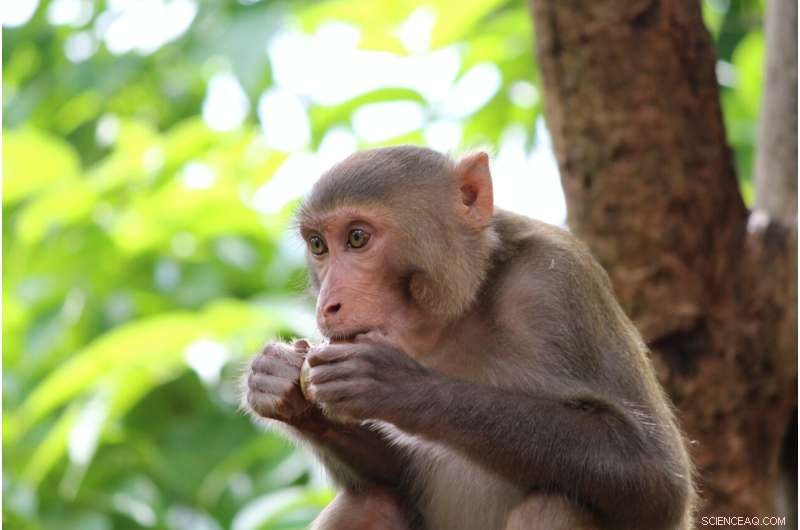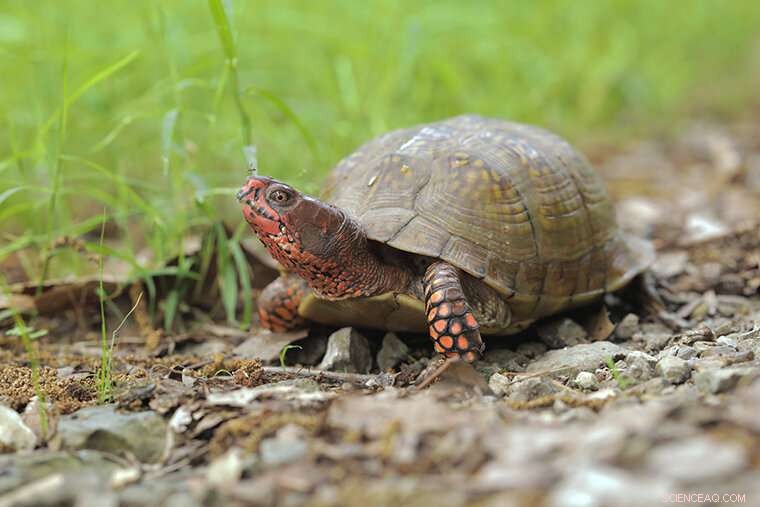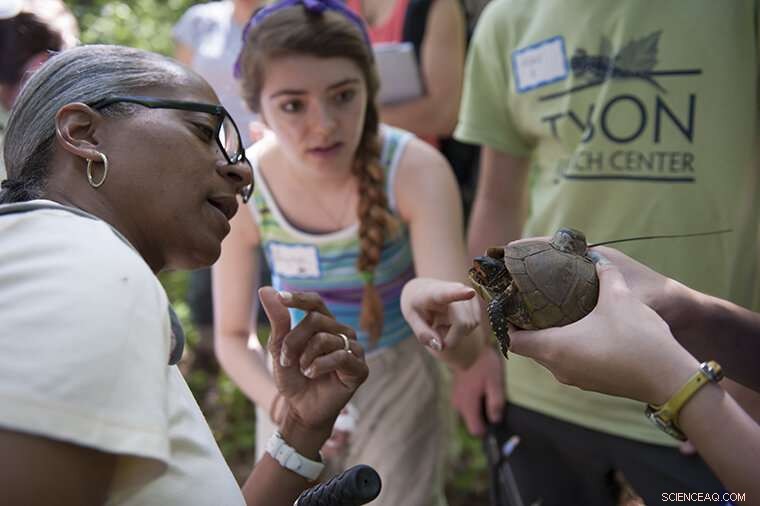
Kredit:Unsplash/CC0 Public Domain
Mikrobiomet är samlingen av mikrober som koloniserar en livsmiljö, människokropp eller annat. På grund av banbrytande mikrobiomforskning vid Washington University School of Medicine i St. Louis, förstår människor runt om i världen nu mycket mer om tarmmikrobers grundläggande roll för människors hälsa och sjukdomar.
Djur och växter är också beroende av tusentals olika mikrober för att hålla dem vid liv. Även om mindre är känt om dessa föreningar, undersöker en ny generation forskare relationerna mellan en gömd armé av mikrober och varelserna de stödjer och befäster. Dessa mikrober av olika ekosystem (mDivE-STL) är i fokus för ett forskningssymposium den 3 oktober anordnat av Living Earth Collaborative.
Vid flera forskningsinstitutioner över St Louis studerar forskare både mänskliga och icke-mänskliga mikrobiomer. Detta symposium anordnades för att hjälpa till att främja en gemenskap av forskare som studerar olika mikrobiella system samtidigt som de drar nytta av den stora lokala styrkan i mänsklig mikrobiom expertis.
Ta till exempel forskare som studerar svarta vrålapor (Alouatta pigra) i Nord- och Centralamerika. Dessa stora, karismatiska apor är kända för att göra ett av de mest högljudda ropen i de tropiska skogarna i Mexiko, Guatemala och Belize.
Som trädboende växtätare konsumerar svarta vrålapor främst träd och vinblad, blommor och frukter. Eftersom de saknar enzymer som kan smälta cellulosa – kolhydraten som utgör bladcellsväggen – förlitar sig svarta vrålapor på jäsning som utlöses av deras tarmmikrobiota för att få den energi de behöver från dessa livsmedel.
Hela den processen kan vara mycket mer dynamisk än vad man tidigare insett, enligt forskning från forskare vid Washington University. Det börjar dyka upp bevis för att dietrelaterade tarmmikrobiella förändringar buffertenergi och näringstillgänglighet för djur som svarta vrålapor.

En vild sköldpadda vid Tyson Research Center, Washington Universitys miljöfältstation. Med stöd från Living Earth Collaborative har forskare utökat St. Louis Box Turtle Project för att karakterisera de inhemska mikrobiomen hos tretåiga boxsköldpaddor. Kredit:Thomas Malkowicz / Washington University
Elizabeth Mallott, biträdande professor i biologi inom konst och vetenskap, använder metabolomik för att undersöka hur mikrobiella metabolismer reagerar på förändringar i vad och hur mycket deras värdar äter. Hon genomförde nyligen en studie med en population av vilda svarta vrålapor som årligen upplever tre distinkta årstider som påverkar deras dieter:en våt, fruktdominerad säsong; en torr, lövdominerad säsong; och en torr, fruktdominerad säsong.
"Vi kan se att när aporna äter mer av ett specifikt näringsämne, metaboliserar tarmmikroberna det näringsämnet mer", säger Mallott, första författare till forskningen publicerad i Molecular Ecology . "But beyond that, what was exciting is that we could look at the interactions between the microbes and the metabolites in different seasons, including seasons where the monkeys were limited nutritionally or energetically by the food that was available in their environment."
Microbes tend to compensate during lean times, Mallott discovered, prioritizing functions that provide more nutrients to the host. But that system falls apart when food availability becomes truly limited.
"Then the microbes seem to be scrambling. They just try to steal as many nutrients from each other as possible," said Mallott, who also looks at how environmental variation impacts the gut microbiome in humans.
Microbes could benefit species conservation
Studying the microbiomes of animal populations that thrive in the wild is important because it may provide researchers with candidate microbes and microbial consortia that could be used to improve disease resistance, nutrient absorption and ultimately the fitness of threatened species or animals that reside in degraded habitats.

Visitors take a close look at “Parkey,” a turtle tagged and tracked as part of the St. Louis Box Turtle Project. With support from the Living Earth Collaborative, researchers have expanded the project to characterize the native microbiomes of three-toed box turtles. Credit:Sid Hastings / Washington University
This is true for mammals including black howler monkeys, but also reptiles such as the Missouri native box turtles—including the ones that the Saint Louis Zoo Institute for Conservation Medicine has studied at two sites in the St. Louis area since 2012, as part of the St. Louis Box Turtle Project.
With support from the Living Earth Collaborative, researchers are expanding that effort to include characterizing the microbiomes of three-toed box turtles and exploring how they vary within and between populations. Scientists from the laboratory of Fangqiong Ling, an assistant professor of energy, environmental and chemical engineering at the McKelvey School of Engineering, are collaborating on this turtle project to integrate microorganisms into the wildlife conservation toolbox.
"In general, wildlife microbiomes—the bacteria, archaea, protists and viruses that are found inside and on the body—are an understudied aspect of biodiversity conservation," said Sharon L. Deem, director of the Institute for Conservation Medicine and of the Saint Louis Zoo WildCare Institute Center for Chelonian Conservation.
Deem and Mallott are both scheduled to speak at the Oct. 3 research symposium, which was organized by Ling, Gautam Dantas, a professor of pathology and immunology at the School of Medicine, and Jonathan Losos, the William H. Danforth Distinguished University Professor of biology in Arts &Sciences and director of the Living Earth Collaborative.
About half of the microbiome research that will be presented relates to animals, plants and the environment, while the rest is more closely related to human health.
"You can't really understand the human microbiome and its interesting dynamics if you don't consider it in the context of the environment," said Dantas, who describes the microbiome research in his laboratory as being about 90% focused on humans and 10% in other habitats, including plants, soil and the built environment. "Even if you're purely focused on the microbes in humans, you're not going to be able to explain the important dynamics of those of that ecosystem if you don't understand the interactions in microbes within and on the body, and where those microbes come from." + Utforska vidare